Country guides

Things to do in Vietnam
A trip through Vietnam is an exciting journey from south to north, beginning in the vibrant city of Saigon (Ho Chi Minh City), the country's largest urban centre and economic hub. This bustling metropolis is a captivating blend of old and new, where gleaming skyscrapers sit beside ancient temples, and street vendors sell their wares outside modern shopping malls.
From Saigon, travellers can venture to the lush Mekong Delta for a chance to explore the famous floating markets and experience life on the water. History buffs should make time for a visit to the Cu Chi Tunnels, a reminder of the country's war-torn past, while beach lovers can unwind on the tropical shores of Mui Ne.
Heading north, the charming city of Hoi An is a must for visitors, who're sure to relish its well-preserved Old Town and tranquil atmosphere. The ancient Imperial City of Hue lies just a few hours away, and is now known for its incredible food scene.
As travellers continue to the north, the capital city of Hanoi stands as a testament to Vietnam's rich history through a thousand years of heritage. French and Chinese influences are visible in the city's architecture, while the narrow streets of the Old Quarter bustle with energy, offering a mix of traditional food vendors, trendy cafes, and lively art galleries. In contrast, the French Quarter's wide boulevards are lined with grand colonial-era buildings.
For those looking to escape the city, a scenic train ride to Sapa offers stunning views of terraced rice fields and misty mountains. Meanwhile, the rugged coastline holds its own treasures, including remote beaches and the breathtaking limestone islands of Halong Bay. Just south of Hanoi, Ninh Binh offers a tranquil rural retreat with picturesque rivers winding past dramatic cliffs, and farmers tending to their fields with water buffalo.
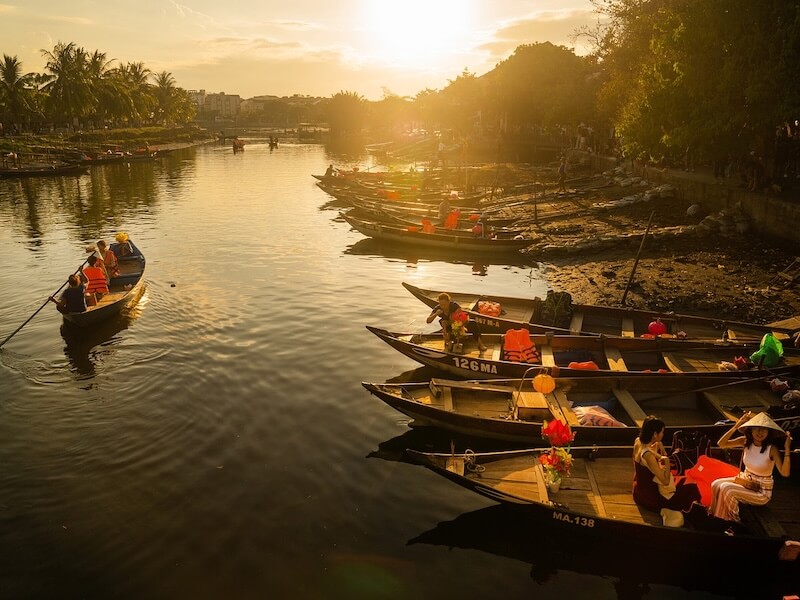
Hoi An
The quaint riverside town of Hoi An was an important port town and one of the major trading centres in South East Asia during the 16th and 17th centuries. The cultural influences o…
Hoi An
The quaint riverside town of Hoi An was an important port town and one of the major trading centres in South East Asia during the 16th and 17th centuries. The cultural influences of the Japanese and Chinese merchants are still evident today in the town's architecture, with the famous Japanese Covered Bridge and the distinctly Chinese atmosphere of the Old Quarter forming part of its unique character.
A UNESCO-listed town, Hoi An has preserved much of its heritage and has remained largely void of traffic and pollution. Lining the narrow streets are two-storey Chinese shops, with charming wooden facades and tiled roofs, merchants' homes, Assembly Halls and temples that preserve an ancient character. On the 15th day of every lunar month, the ancient character of this sleepy town takes on fairytale proportions, as porches, streets and windows are lit by the glow of coloured lanterns; a practice reminiscent of the old days and aimed at retaining the spirit of the past.
Hoi An is becoming an increasingly popular tourist destination, not only for its attractive old-world atmosphere and genuine friendliness, but also for its restaurants, serving delicious Hoi An specialities, and tailor-made clothes. Rows of little tailor shops with rolls of fine silk offer the chance to have beautiful garments made up within hours; however, the insistence of the tailors can be annoying.
Two miles (4km) to the east of Hoi An is the beach of Cua Dai, considered to be one of the most beautiful beaches in Central Vietnam, with its long, white and sandy coastline. From Hoi An, visitors can make trips to the large marble rock formations 'The Marble Mountains', which are closer to Da Nang, or take a short river cruise. Travellers would be remiss not to take the time to visit Hoi An, if only to take a moment to bask in its history.
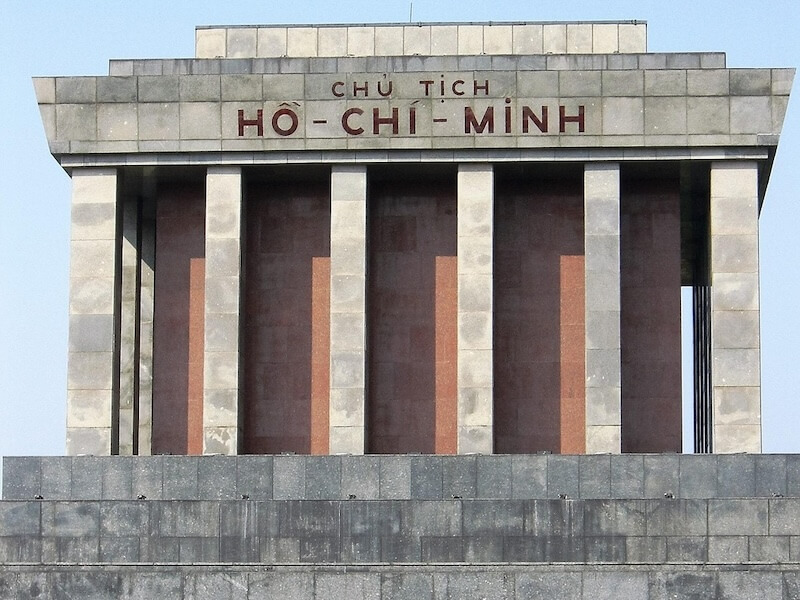
Ho Chi Minh’s Mausoleum
Ba Dinh Square was where Ho Chi Minh read out the Declaration of Independence in 1945, and is the site of annual national celebrations today. The Ho Chi Minh Mausoleum dominates th…
Ho Chi Minh’s Mausoleum
Ba Dinh Square was where Ho Chi Minh read out the Declaration of Independence in 1945, and is the site of annual national celebrations today. The Ho Chi Minh Mausoleum dominates the site's west side and is where the embalmed body of the beloved public figure, 'father of the modern state', and 'liberator of the Vietnamese people' is displayed. The body of Ho Chi Minh is enclosed in a glass case, the traditional way to honour famous communist leaders. Security is tight, there's a strict dress code and it's imperative to maintain a respectful demeanour while inside; this also means no photographs. Nearby is the Ho Chi Minh Museum that commemorates his life, housing a collection of military orders, correspondence, manifestos and photographs that illustrates the crucial role he had in the country's history.
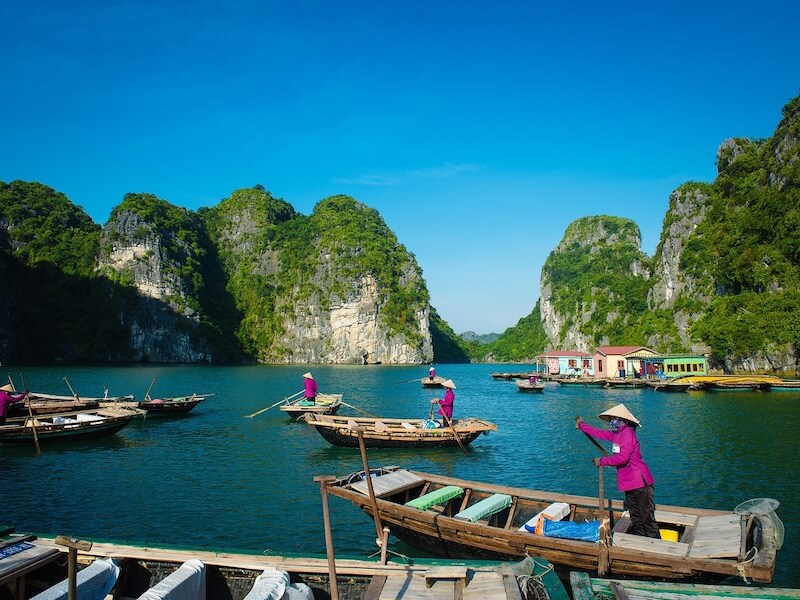
Halong Bay
The natural wonder of Halong Bay has been declared a UNESCO World Heritage Site. Renowned for its spectacular scenery and limestone grottos and caves, the bay is peppered with over…
Halong Bay
The natural wonder of Halong Bay has been declared a UNESCO World Heritage Site. Renowned for its spectacular scenery and limestone grottos and caves, the bay is peppered with over 1,600 inlets and tiny islands emerging almost mystically out of the emerald waters of the Gulf of Tonkin. Wind and wave erosion have scored the site to form dramatic rock shapes, many of which contain caves.
Many of the islands have been named for their astonishing resemblance to their namesakes, such as Dragon, Incense Burner, Pair of Roosters and Man's Head Islands. The weird protuberances have been at the source of several local legends, particularly about a dragon whose thrashing tail created the bay and its islands. The name Vinh Ha Long means 'where the dragon descended into the sea'.
The most impressive cave is the Hang Dau Go (Grotto of the Wooden Stakes), an extensive grotto with rock formations presenting various eerie images in the mysterious light. It was named from the Battle of 1288 when General Tran Hung Dao prepared hundreds of stakes to be planted in the riverbed of the largest chamber to counter a boat attack. Nearby
the beautiful Hang Thien Cung cave is famous for its sparkling stalagmites and stalactites. When booking a cruise in advance, travellers should consider reserving a night or two to experience Halong Bay at its most picturesque: sunrise, sunset and star-scattered night.
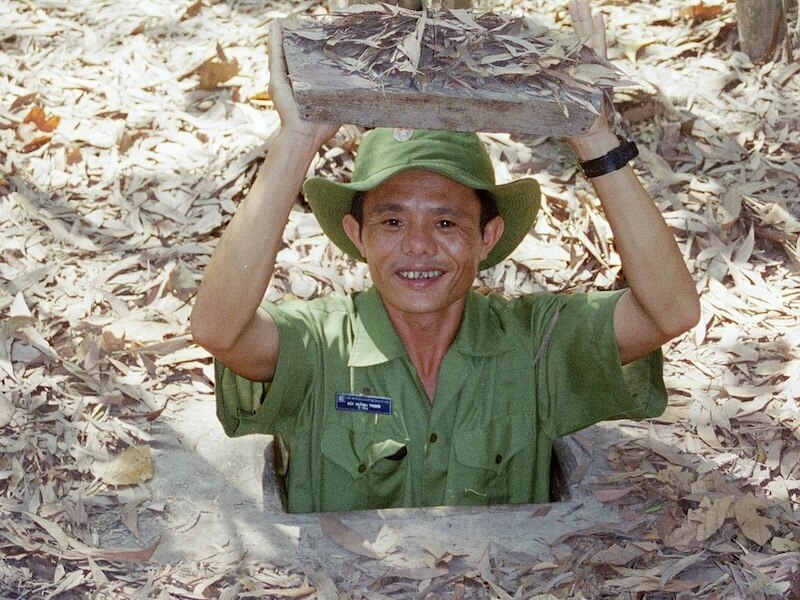
Cu Chi Tunnels
The Cu Chi Tunnels system is an underground network of tunnels dug in the 1940s by the Vietnamese as a place to hide during the fight against the French. The network was later expa…
Cu Chi Tunnels
The Cu Chi Tunnels system is an underground network of tunnels dug in the 1940s by the Vietnamese as a place to hide during the fight against the French. The network was later expanded and used in the American War. Today the system is more than 150 miles (250km) long. It's comprised of winding tunnels and unlit offshoots, secret trap doors connecting narrow routes to hidden shelters, local rivers and tunnels reaching to the Cambodian border.
It was once a sprawling city of improvised hospitals, living quarters, kitchens and fresh water wells, with some tunnels barely large enough to wriggle through. The plan was to launch surprise assaults on the enemy, and then disappear; this strategy was so successful that the superior firepower of the French and American armies was insufficient in the face of continuous ambushes in which the assailants seemed to vanish into thin air.
Many of the tunnels have been enlarged to allow visitors the dirty and claustrophobic experience of crawling through a portion of the underground network, past secret trapdoors and booby traps laid against invasion. The two main sites, Ben Dinh and Ben Duoc, are different in that one was constructed specifically for tourists (Ben Dinh) and the other was actually used in war (Ben Duoc). Due to their popularity with tourists, hard-sell vendors can be a constant hassle among the touring throngs.
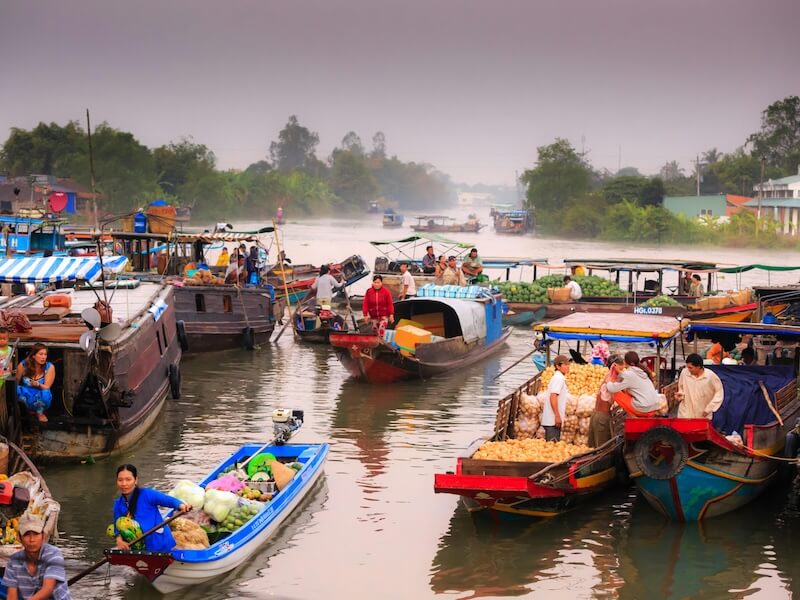
Mekong Delta
The delta is a vast network of waterways formed by the Mekong River. It's surrounded by a fertile patchwork of endless green rice paddies, orchards and swamplands, where most of th…
Mekong Delta
The delta is a vast network of waterways formed by the Mekong River. It's surrounded by a fertile patchwork of endless green rice paddies, orchards and swamplands, where most of the country's rice is grown. Not only does the Mekong River irrigate what is known as 'the rice bowl of Vietnam', it also serves as a vital form of transport.
A unique way of life has evolved among the villagers that have lived on or beside the river for centuries. The best way to experience the delta is by boat, joining the rowing boats and fishermen, rickety houseboats, ferries and traditional sampans on the brown water. On the banks are small villages, vegetable gardens, fish farms and stilted houses. Trading is carried out between boats at floating markets, where whole sections of the river are covered by bobbing merchants who advertise their wares, often hung from long bamboo poles.
There are several towns in the region from where visitors can arrange boat trips if they haven't already been offered as part of an organised tour. Tourists should try to avoid the rainy season, as the tides may be too high for canal travel. There's an impressive range of local dishes on offer and, besides seafood, there are opportunities for adventurous travellers to sample snake, eel and bat.
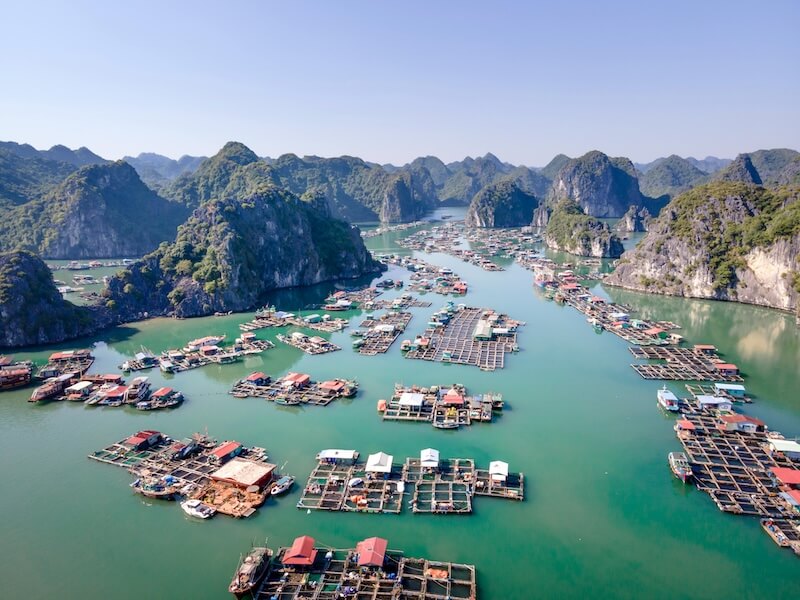
Cat Ba island
For most, a trip in Halong Bay means at least a night on Cat Ba Island. Many select a package tour of one night on the island and one on a boat, but Cat Ba is worth investing extra…
Cat Ba island
For most, a trip in Halong Bay means at least a night on Cat Ba Island. Many select a package tour of one night on the island and one on a boat, but Cat Ba is worth investing extra time in. This 54 sq mile (140 sq km) island offers impressive beach relaxation, and hardcore outdoor activities include kayaking, trekking and world-class rock climbing.
Travellers who wish to relax can choose between three beaches that are within walking distance of town. Each is spacious and all are protected inlets with views of Halong islands. Beaches one and three are the most secluded and offer beautiful views from the short walks along surrounding cliff lines.
Those looking for something more rugged can visit the many limestone cliffs dotting the island, as they're ideal for rock climbing; hotels located on the town's main strip offer guides and gear. Various treks range in length but most are fairly steep. However, the reward is well worth it, as they give a bird's-eye-view of the island's national park, which is also home to the rare Cat Ba Langur.
All hotels can arrange excellent boat tours of the surrounding islands. These include visits to deep caves with stalagmites and stalactites, secluded swimming holes, floating fish farms and kayaking. The tour is the same regardless of who it's booked through, so the cheaper the better. Whether it's been a relaxing day of sun and sea or one of thrilling adventure, it must end at one the bay's floating restaurants, which have some of the best seafood in Vietnam.
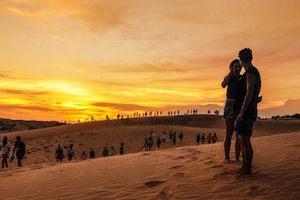
Mui Ne
Mui Ne is Vietnam's most western style resort beach. The city itself is a typical Vietnamese fishing community sporting a fleet of beautiful fishing boats but with little to see or…
Mui Ne
Mui Ne is Vietnam's most western style resort beach. The city itself is a typical Vietnamese fishing community sporting a fleet of beautiful fishing boats but with little to see or do in town. The beach beside it, however, is home to luxury resorts and hotels, while cheaper guesthouses can be found across the road or closer to town. A variety of water activities are available including surfing, kite surfing, jet-skiing, and sailing. The young and tireless will enjoy the beach and roadside bars, where cheap drinks and electro music carry on late into the night. Most parts of the long six mile (10 km) stretch of beach resemble the tropical paradise Mui Ne has always been toted as, but other sections have experienced coastal erosion. Travellers should keep this in mind when selecting a resort. There are red-coloured sand dunes close to town, but beyond those lie much larger white sand dunes, which are worth the extra half-hour trip. For a small tip, children will rent out sand sleds and demonstrate how to surf the dunes. One of Vietnam's top golf courses is also just outside the city. Mui Ne is a scenic five-hour motorbike trip from Vung Tau or five to seven-hour highway bus ride from Ho Chi Minh City.
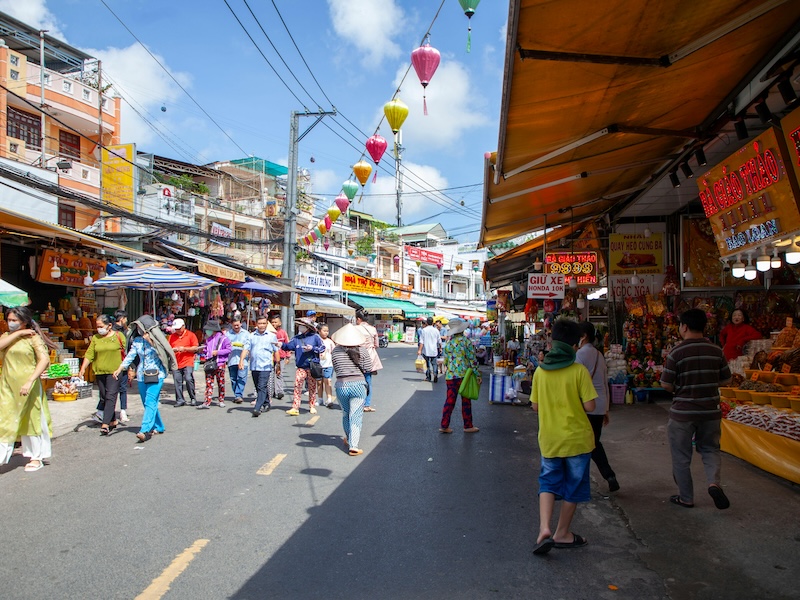
Da Lat
Located in Vietnam's central highlands region, Da Lat is the capital of Lam Dong Province and a popular tourist destination. It offers sun-burned travellers an Alpine haven, ideal …
Da Lat
Located in Vietnam's central highlands region, Da Lat is the capital of Lam Dong Province and a popular tourist destination. It offers sun-burned travellers an Alpine haven, ideal for rest and recuperation. Full of beautiful French Colonial architecture, the city's natural surrounds are also staggeringly picturesque, attested to by the fact that in Vietnamese, 'Da Lat' means 'city of thousands of pine trees'.
There's much to see and to explore in the city's misty surrounding valleys, including Truc Lam, a working Buddhist monastery in a pristine pine forest setting; Lang Bian, a nearby mountain with spectacular scenery, that visitors can hike up in three hours; the Da Lat Flower Park, where the area's famous orchids and roses take centre-stage; and Elephant Falls, a striking collection of waterfalls that is guaranteed to interest the most jaded of travellers.
With a wonderfully temperate year-round climate (it's nicknamed 'the city of eternal Spring') Da Lat, much like Darjeeling in India, is often used by travellers as a restful place to stop and catch their breaths. The best time to visit Da Lat is in the dry season, which lasts from November to April.
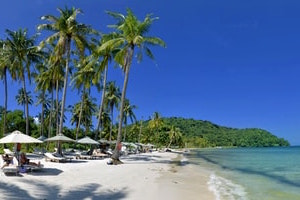
Phu Quoc
Located in the Gulf of Siam, Phu Quoc is Vietnam's largest island, and is fast becoming a heavyweight tourist destination. The densely forested, mountainous island is ringed by som…
Phu Quoc
Located in the Gulf of Siam, Phu Quoc is Vietnam's largest island, and is fast becoming a heavyweight tourist destination. The densely forested, mountainous island is ringed by some of the most beautiful, unspoilt beaches in the whole of Southeast Asia. Accessible by sea or air, Phu Quoc is the ideal place to spend a week or two.
There will be more than enough to entertain visitors between relaxing on the beach, sampling some of the famous seafood, shopping for pearls in the fishing village of Ham Ninh, or heading off to Phu Quoc National Park to hike and swim in a tranquil mountain pool. The island is famous for its fish sauce (nuoc mam), which is an essential ingredient of all Southeast Asian cooking, and a wonderful gift for friends and family back home.
For those looking to be active on the island, Rainbow Divers offer excellent opportunities for snorkelling and scuba-diving; and it's highly recommended that visitors rent a scooter or moped for their time on Phu Quoc, as it has to be the coolest, easiest way to zip around. The best time to visit the island is in the dry season, which lasts from December to May. Although Phu Quoc is currently experiencing rapid development on the east coast, it's still possible for travellers to explore relatively untouched areas of the island.


